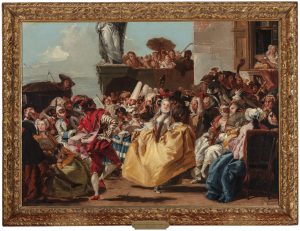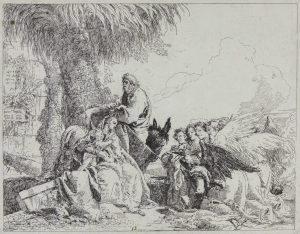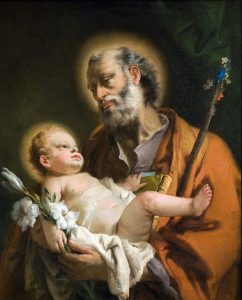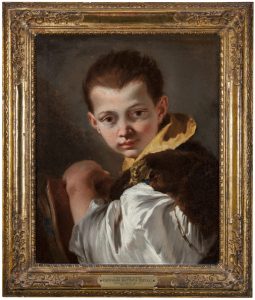NOMA’s major spring 2017 exhibition A Life of Seduction: Venice in the 1700s prompted a reevaluation of the paintings in the permanent collection made in eighteenth-century Venice. Among other new discoveries, three works by Giovanni Domenico Tiepolo (1727-1804), more simply called Domenico, are now identified. Each work is representative of Domenico’s main achievements, as a vivid commentator of theater and scenes of contemporary life, painter of Saint Joseph, and accomplished etcher.
Working mainly as his father’s assistant on grand architectural painting projects, Domenico is best known for his vivacious fantasies depicting Commedia dell’Arte characters executed with a vibrating touch and boisterous mood. NOMA’s The Minuet exemplifies this aspect of his work and was included in A Life of Seduction. The painting depicts a traveling troupe performing a minuet. At the end of the play, the lovers Isabella and Lelio dance in celebration of their love after misunderstandings and earlier denials. Formerly considered a studio piece, we now may consider the picture a work close to the artist.
Domenico also came to specialized in depictions of Saint Joseph, which range from light-heartened and playful to more solemn, tender depictions. As part of the research for the exhibition, NOMA’s Saint Joseph and the Christ Child was identified as by his hand in comparison with an autograph painting of the same subject in Stuttgart. Donated by Tulane professor W. P. Caar, the painting entered the fledgling collection of European Paintings in 1956 as a work by his father Giovanni Battista Tiepolo (1696-1770), though the attribution was always doubted and, rather, associated with Venice sometime after the latter’s death. In the past twenty years, scholarship has arrived at a clearer view of Domenico’s art and a core group of paintings that align closely in paint handling, expression and figure modeling are now considered by his hand, and within which NOMA’s painting convincingly conform.
In an intimately cropped vision, Saint Joseph, foster-father to the Christ child, is shown cradling the child, who holds the white lilies of purity and gestures to the bible. The spotlit scene focuses on the body and face of the child, bathing Joseph’s introspective expression in half shadow, which adds to the sense of intimacy and solemn sadness. Certain areas of the painting have been over cleaned and the background has darkened somewhat, though the most important passages remain pristine and fresh. The light as it falls on the lilies, the dry brushstroke of the Christ child’s white satin sash and blanket contrast with the fluid paint describing Joseph’s hands. The quick daubs of colorful flowers on his staff counterbalance to add dimension to the tight cropping and movement of light across the scene, while the glowing haloes add more of a sense of depth. The use of orange is typical of works in Venice in this period in particular. Consistent with the artist’s other depictions of Joseph and the Christ Child, the tenderness between the two is palpable, where Joseph is in contemplation, presumably of the child’s fate and later sacrifice. The feathery treatment of his forehead, eyes, hair and beard creates texture using a dry medium which contribute to the thoughtful tenor of the image.
In seventeenth-century Spain, Bartolomé Murillo and Francesco de Zurburán produced famous depictions of Saint Joseph, while in the early eighteenth century in 1714, Clement XI had composed a new office dedicated to him. It would appear Domenico seized upon the popularity of the saint, for his first signed works were etchings of the subject of Joseph as part of the Flight into Egypt, and he would later specialize in paintings of him, as in NOMA’s picture. The print series was made for the Prince-Bishop of Würzburg, Karl Phillip von Geiffenklau, and completed while Domenico was with his father in the city in the early 1750s working on the celebrated fresco cycle of the of the four continents for the prince-bishop’s residence.
Domenico’s remarkable talent as an etcher grew out of his early training in his father’s studio in the 1740s, and his detailed approach to narrative series is remarkable. From the series made for Karl Phillip, NOMA preserves The Rest on the Flight into Egypt. In contrast to the palpable warmth and intimacy of Domenico’s later paintings, Joseph is here depicted in the traditional manner, as a solemn paternal protector apart from the Madonna and Christ child, who are here visited by angels. Characteristic of Domenico’s etching technique, contours are formed by broken lines that create a sensitive sense of movement, mirroring his technique in painting and drawing, while the extensive range of shallow and deep stippling and hatching create a relief-like effect across the scene, which also guide the eye from left to right, aiding in the narrative approach.
It is commonly noted that Domenico Tiepolo had the misfortune of being born the son of the greatest genius of the eighteenth century. NOMA’s Portrait of Lorenzo Tiepolo by his father Giovanni Battista is one of the prized pictures of the permanent collection and counterpoint to the Saint Joseph and Christ Child. A character study, which is essentially a study of the behavior light, the boy turns toward the viewer as if interrupted while reading. A sense of immediacy is enhanced by the fresh, quick, and fluid brushwork. The gold clasp of his fur vest depicts a laughing satyr’s head, which must be a witty contrast to the sitter, whose innocence is emphasize by the boy’s light-filled, rosy visage and large, glowing eyes. The two paintings by father and son face each other in conversation in the gallery, where, visitors will hopefully agree, the son most definitely holds his own.
—Vanessa Schmid, Senior Research Curator of European Art



